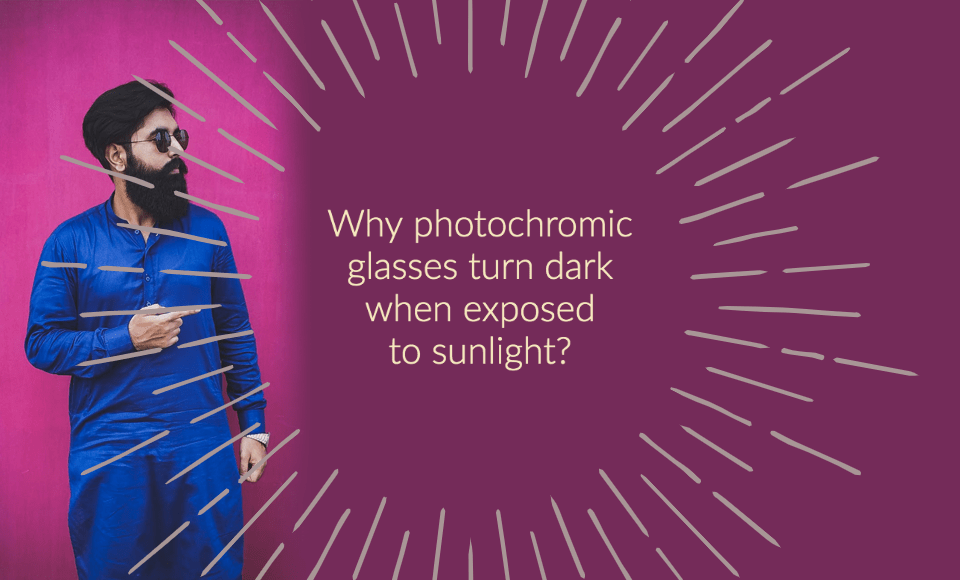The lenses of photochromic lenses are made of glass that is mixed with minute crystals of light-sensitive silver iodide or bromide. The crystals are so tiny that they have a length of only 50 angstroms, and to make its length clearer, a single angstrom is equivalent to 0.0000000001 meters. As these crystals split and scatter under the sunlight, the transparent lenses will automatically start to become somewhat darker in color. The eyes of the wearer are not dazzled or burned by the sunlight anymore because some of the sun rays are obstructed by the crystals. These crystals remain embedded in the lenses, so their effect won’t disappear even if they go back to their transparent structure.
Unlike a liquid that flows out of the strainer whenever you are draining water out of cooked pasta or cleaned vegetables, the photochromic glass does not allow the scattered crystals to flow out or escape from the lenses. As soon as direct exposure to sun rays is withdrawn, the crystals of silver iodide or bromide would fuse together, and the lenses will become transparent again, although the time where they get back to being transparent is much slower compared to the pace when it turned dark under sunlight.
These photochromic lenses have the ability to filter 100% of both UVA and UVB lights. UVA light is the type of ultraviolet that gets through a person’s skin and causes internal damage to it, such as skin aging, wrinkles, and even cancer. UVB light is the ultraviolet that causes sunburn on the skin. UVB can be blocked by all types of glass, while UVA light cannot be blocked by standard glass, which is the one typically installed for windows and eyeglasses.
Who invented the photochromic glasses?
Photochromic glasses were invented in 1964 by William H. Armistead and Stanley Donald Stookey, who were working on creating glasses that can turn dark under sunlight for Corning Glass Works, Inc. The glasses that they invented are considered to be the first mass-produce variable-tint lenses in the world. Interestingly, Stanley Donald Stookey is also responsible for inventing photosensitive glass, a type of crystal-clear glass that is able to capture images whenever it is exposed to short wave radiations like UV light. Photosensitive glass is invented in 1937 but was only introduced in 1947 by Corning Glass Works, and it may have contributed to the development of photochromic lenses.
Although it was invented in 1964, the first commercial photochromic glasses were only introduced in 1991, when Transitions Optical partnered with PPG Industries and Essilor International SA Manufacturing to produce the glasses. In the same year, the photochromic glasses became widely available to the public.
Several improvements were added to the photochromic lenses over the year, but the most significant enhancement to the technology occurred in 2019 when the first photochromic contact lenses were introduced. The contact lenses’ name is the Acuvue OASYS, and it was produced by Transitions with the help of Johnson & Johnson Vision. According to both companies, it took more than ten years to develop the technology to create these special contact lenses. The Acuvue OASYS is a bi-weekly lens, which means that it needs to be replaced with a brand new one after two weeks.
Is there a difference between Transitions lenses and photochromic lenses?
Most people are probably more familiar with the name Transitions lenses rather than photochromic lenses, mainly due to the fact that it is technically easier to pronounce. However, despite their difference in name, both of the said products are the same in terms of materials and features.
Photochromic lenses are the name that really should be associated with the product, as it is its real name, and it is the name that is set by its inventors. As previously stated, photochromic lenses are made up of tiny crystals that react to ultraviolet (UV) radiation and exposure. Aside from the small crystals, photochromic lenses would also be made of other materials such as polycarbonate, plastic, and of course, glass.
On the other hand, Transitions lenses are a brand of photochromic lenses produced by the Transitions Company who is responsible for bringing the lenses to customers of all social statuses. Some people called Transitions lenses as transition lenses with a lowercase “t.”
Do photochromic lenses last forever?
Photochromic lenses can last forever, and their function actually gets better over time. However, what doesn’t last is the frame that it is encased in, as it would only be functioning for two to three years of use. It is recommended that you regularly see your doctor for him or her to inspect any irregularities or damages to your glasses or lenses.
Besides Transitions, there are also other companies that started manufacturing photochromic lenses, and some of these companies are Oakley, Persol, Blkrshades, Intercast, Serengeti Eyewear, and Tifosi. However, some of them manufacture sunglasses that go from dark to darker under the sunlight.
